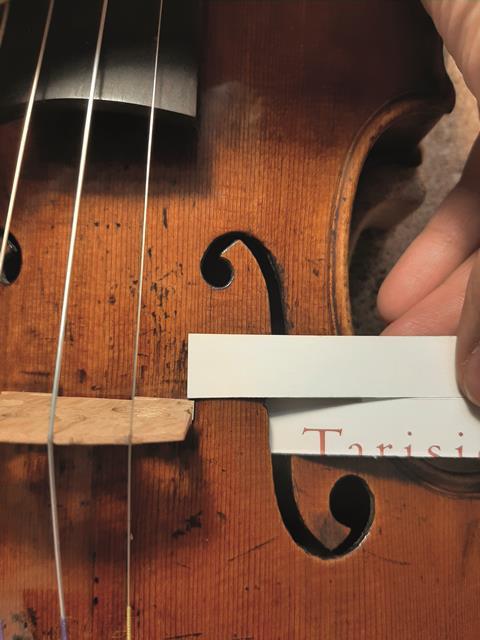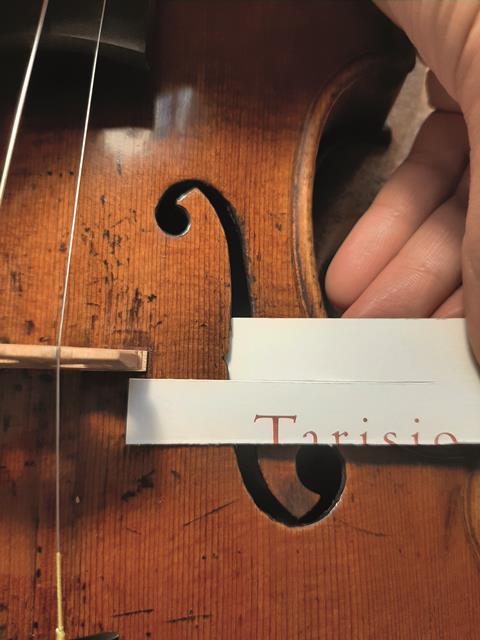What is a soundpost? What does it do? Luthier Cecilia González from the Women in Lutherie community illustrates the enormous role of the little cylindrical piece of wood in an aim to demystify the subject for players
A soundpost is a cylindrical piece of spruce wood that is wedged between the front and back plates inside a violin family instrument (violin, viola, cello, double bass). It is introduced through the treble f-hole and positioned under the treble foot of the bridge. It is fitted with tension, so that it can stand on its own without any glue. The soundpost has a major acoustical and structural effect on an instrument, and its main function is to transmit the vibrations of the string from the top plate to the back plate, while it supports the front and counteracts the stresses of string tension.
The traditional soundpost position on a violin is: the thickness of the bridge foot, divided by two. Take that measurement, from the back of the treble foot of your instrument down, and that should be where the top of the soundpost fits. For example: the foot of your bridge is 5mm, so the soundpost should sit 2.5mm down.

To check your soundpost position, you can use a business card cut lengthwise in half. Cut a straight line lengthwise, leaving the last part uncut as in the picture. Personally, I made mine of translucid plastic and marked it as a ruler to be more precise.

In the other direction, it should be placed symmetrically with the bass-bar, meaning: the bass foot should overlap the bass-bar 1 to 1.5mm on violin and viola, and 1.5 to 2 mm on cellos.

This gives you the measurement on how many millimetres inside the treble foot the soundpost should sit. This is a starting point, as the soundpost position should be tested and adjusted on each individual instrument to accommodate for the musicians need. It is however rare that these measurements are off by more than 1 or 2mm.

When I need to make a new soundpost of an instrument, I start with choosing the correct material. There are many different valid opinions on what makes spruce good for soundposts. Personally, I like to use wood that is the same as the front of the instrument in terms of ring grain lines (each line is a year of growth of the tree), except in extreme cases where the rings might be too close or too wide apart. The grain lines of the soundpost are placed perpendicular to the grain lines of the front. I use the old soundpost as a guide to check the length the soundpost should be, and in the rare cases where I don’t have an old fitting soundpost, I use an old one from my collection.
Both sides of the soundpost should fit perfectly against the plates, with the edges flush, and no shadows around. To achieve this, I cut the areas that are too high with a knife or a chisel. Both sides should be absolutely flat, I like to check the flatness against the back of my chisel. Luthiers use a small mirror inserted in the instrument to check the fit of the post.
It is imperative that only professional luthiers make and adjust soundposts. The amount of delicacy and sensitivity required to make this kind of work take years of practice and cannot be achieved in a DIY environment. A poorly fitted soundpost can permanently damage an instrument. A badly fitted soundpost will cause a dent on the plate on a good day, and a soundpost crack on a bad one. In both cases, a soundpost patch might be required. This is a highly-skilled and expensive repair that consists of opening the instrument, removing original damaged wood from the inside, and substituting it with healthy new wood.
A soundpost crack can also potentially reduce the overall value of an instrument, bringing it down by up to 80% if the crack is on the back plate. If you are unsure about your soundpost´s condition, take your instrument to a luthier. They will evaluate whether the post is in good condition, or if you need a replacement.
Read: 7 tips on adjustments to get the best out of your instrument
Listen: The Strad Podcast Episode #47: Korinthia Klein on basic instrument maintenance
When a luthier makes a new soundpost for your instrument, they should always adjust it for your needs, so do not be scared to ask! A sound adjustment involves slightly moving the soundpost around and having the musician play and listen to the difference in sound until the optimal position is found. Each musician has their own definition on what good sound is, and it can be difficult to explain to another person. We might use different words to describe the same thing or vice versa. Play a scale or piece that involves all registers, ideally no more than 20 seconds long. Always play the same thing so that it is easier to understand the differences in the sound. Describe what you hear in short, concise words.
When I do sound adjustments, I personally like to write down the position of the post, followed by the comments of the musician. This way it is easier to remember and map down what they like and what their ideal sound is like. Be patient with your luthier, they are trying their best to accommodate your needs, and it is not always straight forward. Communication is key in forming a healthy relationship with your luthier, and having someone you trust and can work with will give you the best experience and care that you and your instrument need!





























No comments yet